INTRODUCTION
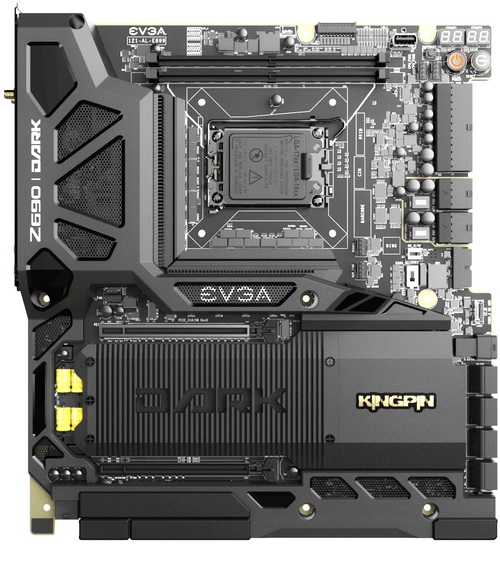
Compared to even just 5 years ago Intel is clearly ramping up development of new motherboard chipsets and CPU models lately and even though their new Z790 chipset is just around the corner (as is their 13th generation of CPUs) the Z690 is still their flagship commercial model. Yes, many manufacturers rushed to release their own models based on that chipset and many of you are probably already aware of the early problems (mostly related to DDR5 compatibility) but the latest models to be released in the market seem to have all but resolved them. Just like with past DARK models in order to serve a more bug-free product EVGA once again took their time in releasing their Z690 DARK KINGPIN motherboard and today that's exactly what i have with me.
EVGA is the #1 NVIDIA authorized partner in channel sales throughout North America. Based on the philosophy of intelligent innovation, market knowledge, and the real time operation, EVGA continues to identify the need in the market place and providing the solution to that need. By offering product differentiation, a 90 day Step-Up program, and other customer focused programs, EVGA is a clear leader in all categories: etail, retail, distribution, and system builders. With headquarters in Brea, CA, EVGA's global coverage includes EVGA GmbH in Munich, EVGA LATAM in Miami, and EVGA Hong Kong. For further information online about EVGA, visit https://www.evga.com.
The latest Z690 DARK KINGPIN motherboard by EVGA is compatible with 12th generation LGA1700 CPUs (will be using the Intel Core i9-12900k for my Z690 reviews) and brings two new things to the table, support for DDR5 RAM (via its two DIMM slots which can hold up to 64GB - DDR4 Z690 models are also available in the market) and PCIe 5.0 cards (for its two EMI shielded and reinforced x16 full length slots). Yes, its three PCIe M.2 sockets are still Gen4 but with PCIe 5.0 graphics cards scheduled to be released before the end of the year this could actually turn out to be a useful upgrade for some (if there are obvious gains between 4.0 and 5.0 of course). As for DDR5 RAM the EVGA Z690 DARK KINGPIN model is compatible with modules exceeding 6600MHz (probably as high as 7200MHz) so that too could prove to be extremely valuable, especially to demanding users and professionals. As for the rest the Z690 DARK KINGPIN sports an impressive 21-phase digital VRM (18+2+1), 100% copper heatsink with twin fans, single PCIe 3.0 x4 slot, six native Intel SATA 6Gb/s ports (support RAID 0/1/5/10), two ASMedia (ASM1061) SATA 6.0Gb/s ports, single U.2 NVMe port, two ARGB and two RGB headers, right angled ports for both power and SATA, dual Intel i225-V 2.5G Ethernet ports, Intel AX211 dual band Wi-Fi 6E/BT v5.2 module and the Realtek ALC1220 onboard sound card together with their very own EVGA NU Audio SV3H615 headphone amplifier. Typically EVGA has equipped their Z690 DARK KINGPIN motherboard with a large number of features aimed towards serious overclockers including PCIe disable switches (allow the end user to disable PCIe slots for troubleshooting), CPU slow-mode switch (can be used to change the CPU ratio on-the-fly to minimum), safeboot button (boots directly into the BIOS without changing your settings - handy if your system will not boot with those settings), power and reset buttons, Probe IT connector, clear CMOS button, BIOS update button and dedicated USB 2.0 port, multi-function indicator and the triple-bios selection switch. As for available connectivity here, we find two USB 2.0 ports (via internal headers), three USB 3.2 Gen1 Type-A ports (2 rear and 1 via internal header), 4 USB 3.2 Gen2 Type-A ports (rear), USB 3.2 Gen2 Type-C port (via internal header), USB 3.2 Gen2x2 Type-C port (rear), two Intel i225V 2.5 GbE (10/100/1000/2500) RJ45 ports, NU Audio amplifier port (for stereo speakers and headphones/headsets) and the Realtek ALC1220 High Definition Audio onboard audio ports. Also, worth pointing out is that the 12th Generation of Intel CPUs is a hybrid line meaning it sports two different core types, P-Cores (performance - support hyperthreading) and E-Cores (Efficiency - lack hyperthreading support) so for this review I’ll be doing tests involving both P and E cores enabled (which add to 16 cores for the 12900k model with 24 threads) and disabled (to see which benefits, if at all, each configuration has over the other).
SPECIFICATIONS AND FEATURES

PACKAGING AND CONTENTS

 Exactly like all their past DARK models EVGA once again uses a black box that just has their logo and the model name at both the front and rear.
Exactly like all their past DARK models EVGA once again uses a black box that just has their logo and the model name at both the front and rear.
The motherboard is placed right between two black pieces of foam (the rest of the bundle is placed inside an accessory kit box).
EVGA cuts no corners when it comes to their bundles and so the Z690 DARK KINGPIN is accompanied by the typical full size virtual guide (made out of thick plastic), dual WiFi Antenna, four SATA 6Gb/s Cables, probelt voltage measurement sensor, six M.2 Thermal Pads, three M.2 screws, motherboard mounting screws, 10 very tall standoffs, plastic case badge, compact USB flash drive (contains the initial drivers), PCI release assist plastic tool and the installation guide.
THE Z690 DARK KINGPIN
The full size plastic guide is something only EVGA offers (to my knowledge) and it's extremely useful when building, troubleshooting or tweaking your system.
I've used and reviewed most motherboards by EVGA and i have to admit that the Z690 DARK KINGPIN seems the sturdiest of them all.
The aluminum heatsink paired with two high-speed fans (40mm probably) should be enough to keep the 21-phase VRM (18+2+1) in check even for serious overclocking.
Using two DIMM slots allows the Z690 DARK KINGPIN to support DDR5 modules up to well over 6600MHz in speeds (64GB max capacity).
Typically, at the top left corner we find two LED post indicators safeboot (black) button, two CPU PWM fan headers, dedicated USB port for BIOS flashing, and the power on/off and reset buttons.

 Further down we find the PCIe disable switches, slow-mode switch and the BIOS selection switch right next to the angled power ports.
Further down we find the PCIe disable switches, slow-mode switch and the BIOS selection switch right next to the angled power ports.
The G2, U2 and SATA data connectors are all placed right next to each other at the lower right of the motherboard (two 4pin angled pump connectors are also present here).
The internal USB headers and the onboard speaker are all located on the lower end of the motherboard right under 2 rubber covers and next to the extra 6-pin PCIe power connector (according to EVGA this connector provides dedicated power to the PCIe x16 slots, augmenting the +12V power provided by the 24-pin and the GPU directly).
Removing the large heatsink reveals the three Gen4 M.2 sockets.
These four Bennic bi-polar acoustic capacitors are part of the NU Audio headphones amplifier.
Moving at the rear I/O we find a PS/2 connector, two USB 3.2 Gen1 ports, BIOS update and reset CMOS buttons, two Antenna connectors, four USB 3.2 Gen2 ports, two 2.5GbE Ethernet ports, USB 3.2 Gen2x2 Type-C port and the 5.1 analog/digital audio output.
This time EVGA has placed a thick backplate at the base of the Z690 DARK KINGPIN motherboard.
Forgot to remove the plastic rubber covers on the lower end of the motherboard which as you can see also reveal the single PCIe 3.0 x4 slot.
As mentioned earlier for this test I’ll be using the Intel Core i9-12900k paired with Neo Forza’s latest Trinity 32GB 6400MHz CL40 DDR5 kit (review soon) and their 2TB NFP425 SSD.
Finally, since for this test I’ll be using 3 different games to measure performance with E cores enabled and disabled I’ll also be using the HOF GeForce RTX 3080 Ti OC Labs Edition.
Z690 DARK KINGPIN V1.14 BIOS
The BIOS tabs have remained almost the same since the previous DARK models so once again from the main screen you can choose between loading preset and automatic overclocks (Gamer Mode and OC Robot), load the default settings or enter the BIOS and adjust settings on your own.
The BIOS has a total of 6 tabs the first of which is the drop down extras menu inside which you can find a very convenient CPU stress test, automatic overclock feature, several OC profiles and the BIOS update and XOC calibrate (NVIDIA card tuning) options.
As with previous models almost everything related to overclocking is placed under the OC Tab. Here you can change the multiplier for both the P and E cores, set the BCLK frequency and of course adjust every voltage you could ever want to or have the need to adjust (worth pointing out is that with E cores enabled you can't increase RING ratio to over 43-44).
As always from the Memory tab you can use one of the available XMP profiles, set the frequency, adjust voltages and of course you can also adjust the timings and enable/disable the write function.
Under the Advanced tab you can access the various CPU technologies (including disabling the E/Atom cores), check information on the CPU and of course adjust everything else related to the mainboard (including resizable bar support) and all the included peripherals such as the audio card, LAN and fans.
Of course, as always you can adjust the time and date and all the various boot options from inside the Boot tab.
Finally, from the save and exit tab you can save your BIOS settings into various profiles, override the boot sequence and restart the system.
ELEET X1 SOFTWARE
If you'd like to skip entering BIOS you can monitor and overclock your system using the ELEET X1 software by EVGA.
As you can all see here you have almost every CPU overclock setting available in the BIOS, just slightly easier and faster to navigate.
The same of course applies to the RAM since you can also tweak timings from within the ELEET X1.
Typically, the software also has a health monitoring tool available, information on the system and lighting adjustment for both the ARGB/RGB headers (6 effects).
There’s also a Wi-Fi tab which can be used to measure Wi-Fi performance.
TESTING METHODOLOGY
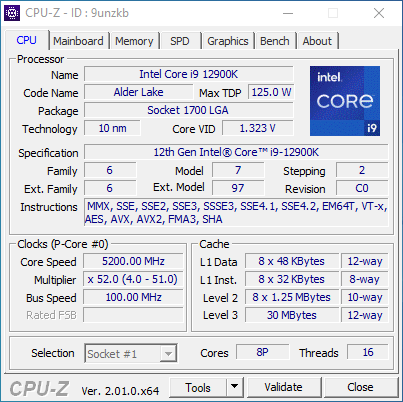

Exactly like used to do in the past each mainboard to arrive in the lab will get mounted on an open-air test bench and will be used for no less than two full weeks (daily tasks and gaming) with a fresh Windows 10 Pro installation. All motherboards arriving here will be tested with the top CPU of that line available to me at the time of each review (I9-9900K for Z390/I9-10900K for Z490/I9-11900K for Z590/I9-12900K for the Z690/Ryzen 9 5900X for X570 and B550) together with 16GB (2x8GB) DDR4 4GHz RAM for the Z390/Z490 motherboards, 32GB (2x16GB) DDR4 4GHz RAM for the Z590 and X570S/B550 and 32GB (2x16GB) DDR5 6.4GHz RAM for Z690 motherboards. Now I don’t know if I will need to change this anytime soon but for now the Intel I9-9900K, I9-10900K and I9-11900K CPUs in each review will be set at 5000MHZ (CPU ratio set to 50 - of course voltages may vary slightly from motherboard to motherboard - RING/Cache frequency at 4700MHZ), the Intel I9-12900K CPU at 5.2GHz (3.7GHz for the E-Cores - RING ratio set to 43) and the AMD Ryzen 9 5900X CPU at 4500MHz.
I did think about pushing each motherboard to the max to see which is the better overclocker but 5.2/5/4.5GHZ 24/7 is more than plenty today, not only in terms of performance but also temperatures (not to mention there are colleagues of mine who have been focusing on maximum overclock potential so that’s also out there). Instead i decided that it'd be far more interesting (not to mention accurate) to see which motherboard is the fastest when using the same exact hardware components/configuration (CPU/RAM/COOLER) with the same exact overclocking frequencies */**. To figure that out I’ll be using several benchmarking programs*** (6 repeats after which the average numbers will get recorded in the charts) like AIDA64, CINEBENCH R20, CPUZ, Passmark Performance Test, RealBench and the Sisoftware Sandra Titanium 2020 version. Needless to say, that between different system configurations these charts also do a great job pointing out the difference in CPU performance.
* Charts will contain other system configurations as well in order to better showcase the performance of each reviewed system.
** Surpassing 4.7GHz with the Ryzen 9 5900X on all cores proved impossible so I chose 4.5GHz as the most balanced choice for all my tests (besides, the latest Intel CPUs in the charts could also climb higher than 5GHz on all cores).
*** To showcase performance differences between E-Cores enabled and disabled on the Intel Core I9-12900K (RING 43 for when enabled and RING 49 for when not) I’ll also be using the latest versions of Horizon Dawn Complete edition, F1 2022 and Forza Horizon 5 (1080p resolution at ultra-high/max settings – average numbers recorded from 3 repeats for each).
TEST RESULTS - AIDA64 / CINEBENCH R20
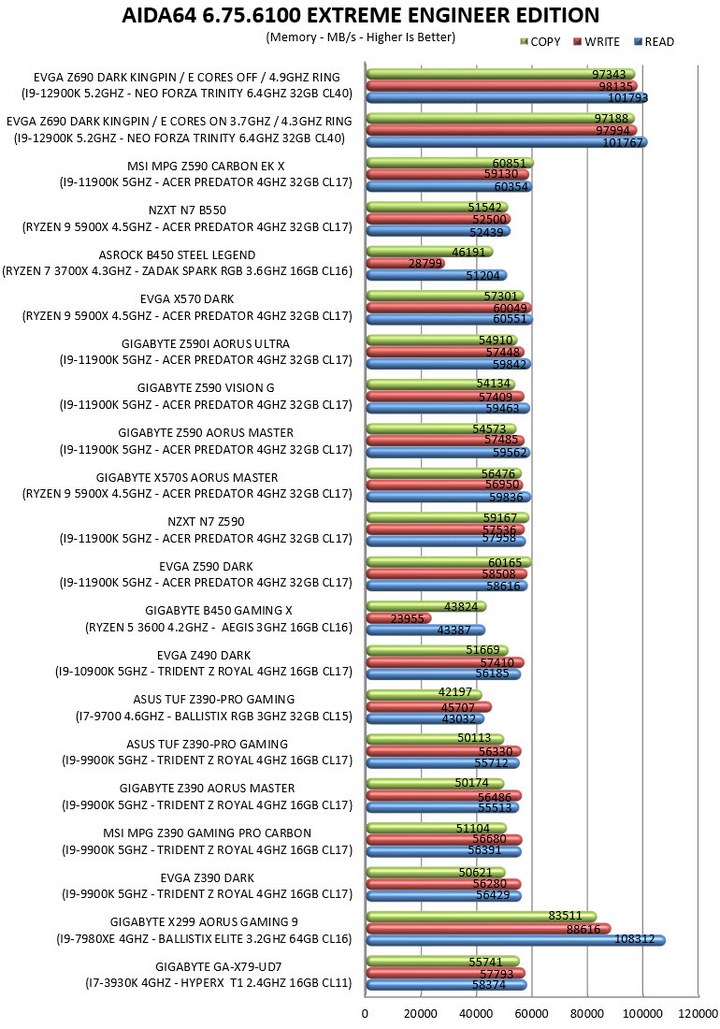

TEST RESULTS - CPUZ / PASSMARK PERFORMANCE TEST


TEST RESULTS - REALBENCH / SISOFTWARE SANDRA TITANIUM 2020



TEST RESULTS – HORIZON ZERO DAWN / F1 2022 / FORZA HORIZON 5



CONCLUSION
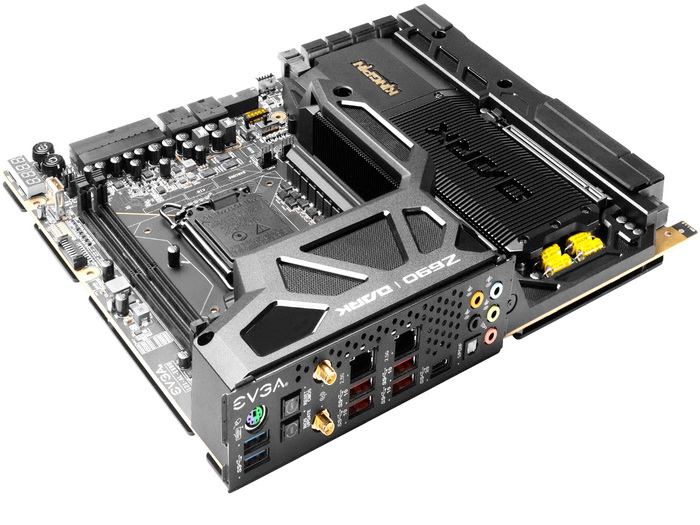
One of the things I really wanted to do in this review was to test and see if gamers would actually benefit by disabling the E-cores (efficiency cores) of their 12th gen Intel CPUs and as you can see from my charts that largely depends on the game. For example, Horizon Zero Dawn Complete Edition doesn’t like it when the E-cores are disabled and as for F1 2022 and Forza Horizon 5 the gains are miniscule, even at 1080p resolution. That’s not to say that every graphics engine will behave in the same way so I recommend trying out for yourselves and choosing the setting that gives you the highest FPS. As for everything else in order to get the Intel Core I9-12900K stable throughout 2 weeks of tests I had to push its main voltage to 1.34V and that does require a good amount of cooling (the Fractal Celsius+ S36 was barely able to provide just that). As for the Z690 DARK KINGPIN motherboard since it’s the first Z690 model to arrive here I can’t really compare it with others but if past EVGA models are any indication it should sit at the top of the “food chain”. Unfortunately, unlike the Z590 DARK the Z690 DARK KINGPIN lacks onboard ARGB lighting and even though that’s certainly not a big deal i did somewhat like it on the previous DARK model. I was also genuinely surprised to see that this motherboard doesn’t come with display outputs even though the 12900K i used does come with the onboard UHD 770 graphics. On the other hand, the Z690 DARK KINGPIN motherboard comes with a thick backplate which makes it look like a tank compared to other motherboards.
EVGA DARK motherboards represent some of the best models in the market and so they are not quite affordable, as expected really (the same of course applies for their equivalents by the competition). Needless to say, the same applies here since currently the Z690 DARK KINGPIN retails for USD549.99 inside the USA (Amazon.com) and for 660.99Euros inside the EU (Amazon.de). For casual users and even some professionals this price may not be justified but for overclockers, enthusiasts and people who aim on getting their hands on the top Intel CPU models (12900K/KS) this motherboard could be your best option currently and since it delivers on everything it certainly deserves the Platinum Award.

PROS
- Excellent Build Quality
- OC Potential (Dual Fan Cooled 21 Phase Digital VRM)
- 2 Reinforced & EMI Shielded PCIe 5.0 slots
- OC Features (PCIe Disable Switches / Slow Mode / Safe Boot / Triple BIOS / Clear CMOS Buttons / USB BIOS Update Port)
- Three M.2 PCIe 4.0 Sockets
- Available BIOS Settings
- NU Audio Amplifier
- U2 Port
- Angled Connectors
- Exterior Connectivity (Dual 2.5GbE Ports / USB 3.2 Gen2x2 / WiFi 6E / BT 5.2)
- Bundle
- 3 Year Limited Warranty
CONS
- Price (For Some)
- Dual DIMM Design
- Only 3 PCIe Slots
- No Display Outputs

 O-Sense
O-Sense











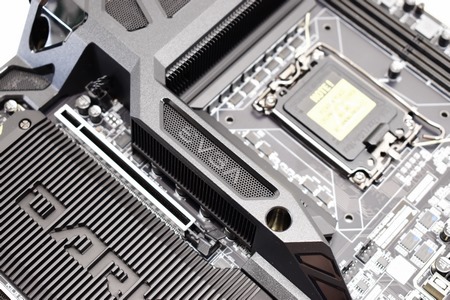





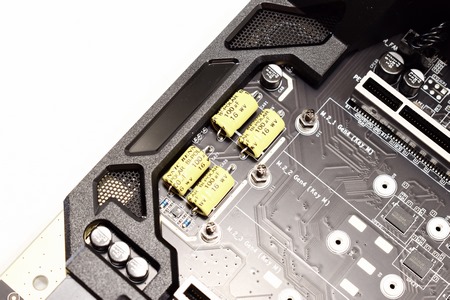








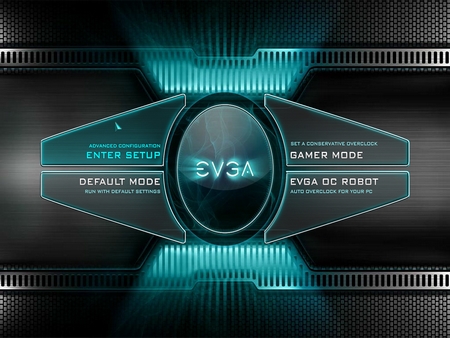
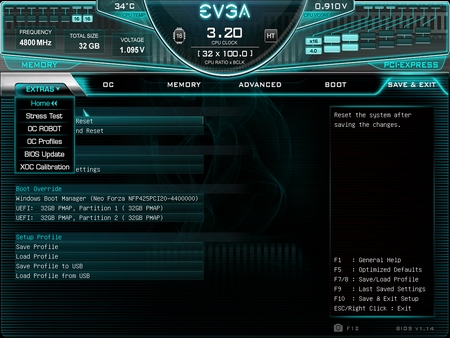




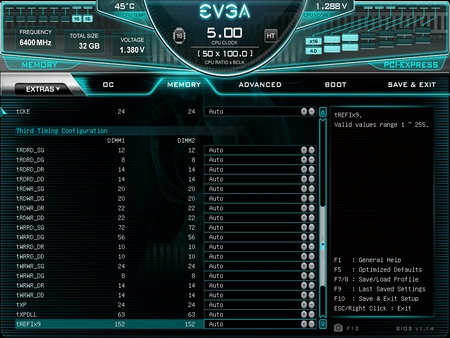























.png)

